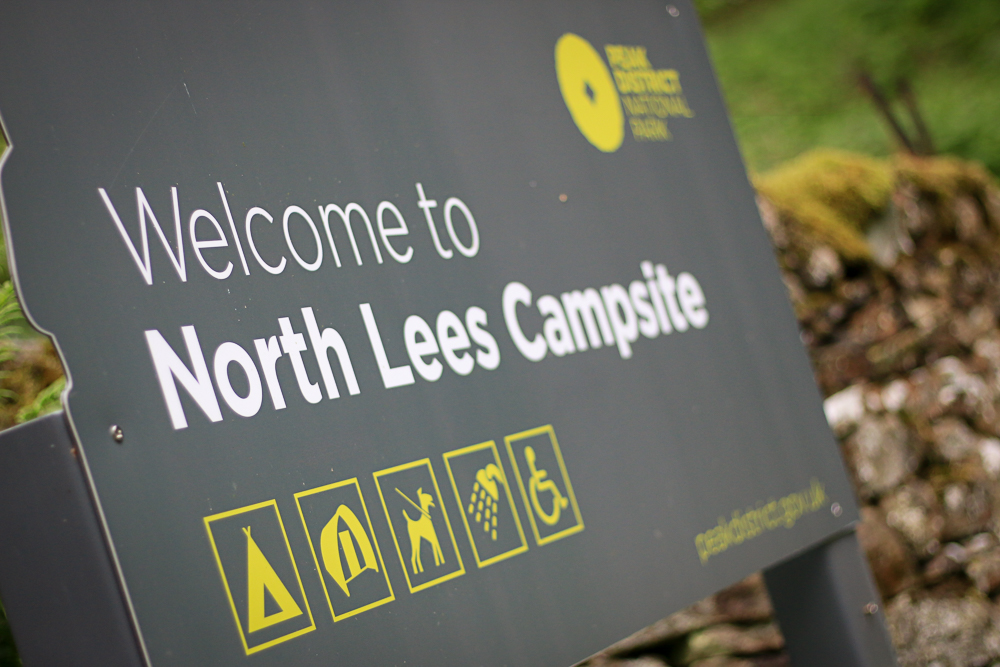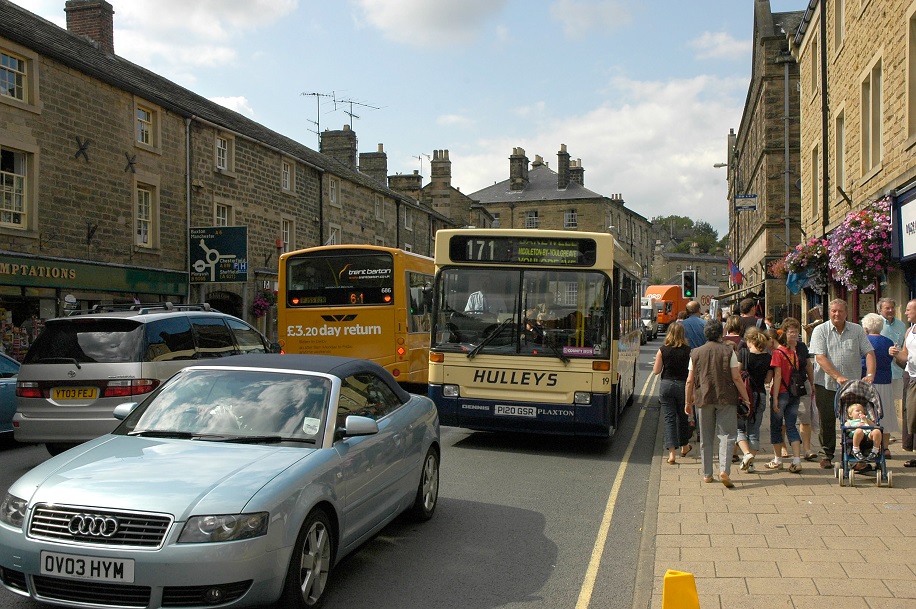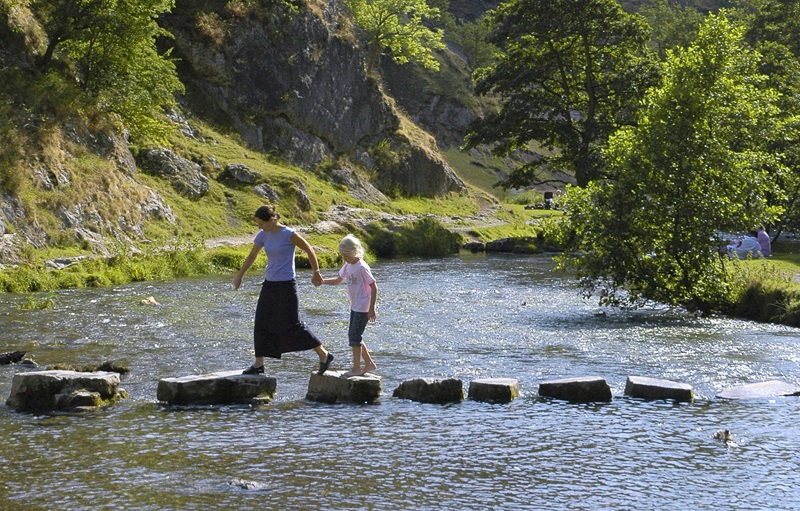An inspiring space for escape, adventure, discovery and quiet reflection
# Peak District visitor destination
The Peak District is located centrally in England putting its treasured upland landscapes within striking distance of many of England’s major cities.
It is also important as the first upland area that people visit when heading north from London and the South East. These upland landscapes offer a diversity that underpins a wide range of experiences; meeting the needs of outdoor enthusiasts, families having fun, group activities as well as people seeking sanctuary in the outdoors.

# The Peak District is one of the most accessible National Parks
The Peak District is served by a network of major and minor roads, which generally provide excellent access to/from and around the area. The main routes from the north and south are via the M1 and M6 motorways which run along the eastern and western edges of Derbyshire and act as important visitor access ‘spines’.
A number of A roads run through the Peak District National Park itself, linking the major urban centres of Manchester, Derby, Sheffield and Stoke-on-Trent with many of the key tourist hubs such as Buxton, Bakewell, Matlock and Belper (primarily the A628, A623, A6, A515, A53, A54 and A537). A network of smaller roads link other towns and villages throughout the area.
# Public transport forms an important element of visitor perceptions of the National Park
Public transport hubs based in the cities and towns surrounding the National Park provide visitors with sustainable access options. Greater Manchester, Sheffield, Stoke-on-Trent and Derby all surround the Peak District National Park, along with a number of other urban areas including Barnsley, Chesterfield, Huddersfield and Macclesfield.

Transport forms an important element of visitor perceptions of the National Park and can heavily influence the choice of gateway. For instance, the National Park has four railway lines, which provide important gateways to the Peak District. The Hope Valley line crosses the National Park, linking Manchester and Sheffield, with stopping services at five National Park villages. The other four railway lines, the Derwent Valley, Glossop, Buxton and Calder Vale lines all provide access to the wider Peak District, with direct links to Manchester, Leeds, Derby and Nottingham, and so in turn act as gateways for onward travel by bus, walking or cycling to the National Park.
However, the popularity of some of the busiest gateway locations within the National Park can have negative effects for the locations themselves and the quiet enjoyment of them. In these locations, a partnership approach to visitor management has been undertaken to ensure that visitor numbers do not exceed capacity. This approach has been traditionally rooted within the National Park Authority’s policy documents such as the Local Plan and Local Development Framework.
# There are a number of premier visitor attractions both within and beyond the National Park boundary
The Peak District has a wide variety of attractions including heritage sites, country houses and parks, reservoirs and caverns. The two spa towns of Buxton and Matlock Bath, lying just outside the National Park, have been popular with visitors since Victorian times. Other surrounding Peak District towns such as Ashbourne, Matlock, Wirksworth, Holmfirth, Marsden and Leek offer a range of tourist amenities. Many of the Peak District villages have annual well-dressing ceremonies, festivals and events during the summer months.
There are a number of premier visitor attractions both within and beyond the National Park boundary including for example a number of caverns, stately homes and reservoirs. The vast majority of visitor attractions are outside the Authority’s control, but offer an area of opportunity in terms of raising the profile of the National Park at key sites. It is realistic to assume that, as these visitor attractions are independently owned and managed, opportunities here are mainly through promoting understanding channels e.g. interpretation, outreach and information provision.
It is difficult to measure an exact number of visitor attractions, as some businesses or sites, like places of worship, have a different primary purpose but are still visited by tourists. Visit England estimate there are around 5,000 to 6,000 visitor attractions in England [1]. In the Peak District, there are many cultural heritage attractions such as the Nine Ladies, which are visited by tourists, but there are no visitor facilities or methods in place to count visitors.
# Impact of quality of landscape and environment on business performance
This is perhaps one of the most important questions of quantifying the economic performance of tourism in National Parks. A study [2] in 2008, included a survey of businesses within the Peak District National Park area. Businesses were asked what impact they felt the quality of the landscape and the environment of this area has on business performance.
Although just over one third (35%) of businesses felt that their business performance was not directly affected by the quality of the landscape and environment, more than half of all businesses (56%) felt that the landscape and environment had either a major positive impact (31%) or a minor positive impact (25%).
Unsurprisingly, a higher proportion of hotels and catering (89%) and retail (69%) mentioned that the landscape and environment had a positive impact on the business. In line with the findings above, a third (35%) of all businesses mentioned that their business did not depend upon the landscape and environment, whereas one third felt they were directly dependent (32%) and 32% were indirectly dependent.
To test the results of the previous questions, by stating the counterfactual, participating businesses were asked if deterioration in the quality of landscape would impact on the performance of their business. More than half (60%) of all businesses felt that they would either be seriously (40%) or to some extent affected by deterioration in the quality of landscape.
# Positive and negative effects of National Park location
Nearly half of all respondents felt that there were no negative impacts from being located in a National Park (48%) [2:1]. The aspect that was most prominently mentioned as having a negative impact was ‘planning and development restrictions’ (33%). Other issues included poor infrastructure and access (7%).
The aspects that businesses most frequently mentioned as being a positive result of the National Park location were that it attracts visitors and tourists to the area (28%) and its effect on business productivity (25%).
What are the gaps in our research & data?
- More data is needed on the location and quality of visitor attractions, sites and other amenities. For example from Trip Advisor or Visit Peak District
- Up to date research on business performance and relationship with the high quality environment through a business survey
# The Peak District has a very diverse outdoor recreation provision offer
The wide variety of recreation activities available in the Peak District results from the diversity of landscapes in close proximity to each other. The gritstone edges and reservoirs of the Dark Peak and the caves and dales of the White Peak are significant attractions for people with many interests including:
- walking
- cycling and mountain biking
- climbing
- horse riding
- hang-gliding and paragliding (air sports)
- caving
- angling
- water sports
- study or enjoyment of heritage, culture, wildlife and landscape
- off-roading
The Peak District has a long association with outdoor recreation activities. In 1932, Kinder Scout was the site of a mass trespass that helped spark the ‘right to roam’ movement and eventually led to the 1949 National Parks & Access to the Countryside Act. Today the Peak District is renowned for the outdoor recreation opportunities it offers, notably:
- 202 square miles (524 km²) of access land
- 1,867 miles (3,005 km) of public rights of way for walking, cycling and horse-riding
- 58 miles (93 km) of dedicated off-road cycling trails based on former railway lines such as the High Peak and Tissington Trails
- National and local long distance trails for walking, cycling and horse riding – including the Pennine Way, Pennine Bridleway, Trans Pennine Trail, Limestone Way and Derwent Valley Heritage Way.
Recreation facilities are provided by many organisations, the key ones include:
- County, metropolitan, district, borough and parish councils
- Peak District National Park Authority
- Water companies
- National Trust
- Forestry Commission
- Private operators.
# There are nearly 2,000km of rights of way
The Peak District National Park is recognised equally as an important area for walking and outdoor recreation, providing 202m2 of open access land and 1,867m of rights of way. Long distance routes include the Pennine Way National Trail and the Trans Pennine Trail. The latest ease of use survey shows that 81% of our rights of way are in good condition. However, they are on a downward trend.

# National Park gateways
There are a number of locations that are seen as gateways to the National Park and these are usually those locations that visitors encounter first when visiting the National Park.
Generally, such sites are located at or near to the National Park boundary. Because of this, they may be the first locations within the Peak District that visitors arrive at. In some cases, visitors may not even be aware that they are inside the Park boundary. Therefore, it is useful for the National Park Authority to be able to provide messaging to make visitors aware of the National Park. A partnership approach with other landowners is vital in enabling this to take place.
Some of the gateway sites are also recreation hub sites; these include Langsett, Macclesfield Forest (Trentabank), Mapleton Lane (Ashbourne) and Saddleworth (Dovestone). Such sites offer a great opportunity to enable visitors to experience the National Park from our surrounding urban areas. They generally offer an experience that is suitable for first time visitors. However, they also offer more challenging opportunities for the more adventurous.
In addition to gateways on the edge of the National Park, the railway stations on the Hope Valley Line also act as National Park gateways. This is particularly the case for both Grindleford and Edale, as the railway passes through two long tunnels at either end of the National Park, with the first opportunities to disembark and explore being Grindleford in the east and Edale in the west. In both cases, they offer easy access to iconic landscapes including Kinder Scout and Longshaw Estate. The other stations inside the National Park at Hathersage, Bamford, and Hope also offer relatively easy access to Stanage and North Lees, the Thornhill Trail and the Great Ridge respectively.
# National Park Recreation Hubs
There are a number of locations within the National Park that offer a range of opportunities for recreation in the open countryside. These locations generally attract large numbers of visitors because of the beauty of the landscape and because they offer a starting point from which visitors can explore the National Park.
Recreation hubs vary in terms of the surrounding landscape, their ownership, and the range of facilities that are on offer to the public. At its simplest, a recreation hub may consist of unmarked parking facilities and waymarking to direct users into the surrounding countryside. At the other end of the scale, there may be a range of facilities, including a café, toilets, a visitor centre, mounting blocks for horse riders or a cycle hire facility.
Many recreation hub sites within the Peak District are associated with the utility companies and reservoirs that provide water to the surrounding urban areas. These include sites such as the Upper Derwent Valley (Severn Trent Water), the Goyt Valley (United Utilities) and Langsett (Yorkshire Water). Over the years, the National Park Authority has built partnerships with the utilities companies to provide suitable facilities at such locations to enable the surrounding countryside to be used for recreation and leisure visits.
In some cases, recreation hubs are linked by footpaths, bridleways or trails. For example, the Eastern Moors, Longshaw and North Lees Estates have good footpath and bridleway links. Similarly, the National Park has a number of multi user trails including the Monsal, Tissington, High Peak and Manifold Trails. All of these trails use former railway lines, which linked stations within the National Park. In many cases, the former railway stations act as recreation hubs from which the trails are accessed. These include Hassop Station, Millers Dale Station, Hartington Station and Hulme End Station.
Where recreation hubs are particularly popular, it can fuel demand for new or improved facilities such as additional parking, cafes and toilets. However, in some locations the quality of landscape or the designations accorded to a location for its wildlife or habitats can severely limit opportunities for such development. The Authority’s approach is to direct such development to those locations where the impact can be absorbed without harm to the National Park’s special qualities.
The National Park Authority is currently preparing a Recreation Hubs Supplementary Planning Document to guide how recreation hubs sites are developed to cater for visitors to the National Park. The intention of the document is to provide a balanced approach in relation to our statutory purposes. The preparation of the document included a series of recreation hub site audits and surveys to establish how such sites are used and where there is scope to improve facilities for visitors.
# Recreation Hubs Survey Data
The overall response from surveys carried out at recreation hubs demonstrates both the local catchment of the National Park and its importance as an attractor at a national and regional level [3].
Face-to-face interview surveys were undertaken at a number of recreation hubs across the Peak District National Park in August 2016. Almost half (44%) of those interviewed travelled less than 20 miles from their home postcode to access the various sites across the National Park, with 17% travelling 10 miles or less. 13% travelled 150 miles or more. There is some disparity across the different sites, however for the majority the 11-20 mile catchment provided the highest number of visitors (Curbar Gap, Dovestone, Langsett, Torside, Macclesfield Forest, Millers Dale, North Lees and the Upper Derwent Valley). Castleton, the Goyt Valley and Mapleton Lane had a high percentage of visitors from further away (more than 50 miles); however, the sample sizes are quite small.
Interviewees were asked for their opinion with regard to facilities for visitors. Overall, across all of the sites, a total of 366 respondents (76%) thought that the facilities were satisfactory, whilst 101 (21%) thought that they were not.
Those respondents who indicated that they were not satisfied with the facilities were asked to explain in what way they thought facilities were unsatisfactory. Whilst there was a lot of variation across the sites, there were common themes relating to toilet facilities, parking including charging, the provision of bins and the provision of refreshment facilities.
# National Park Authority visitor infrastructure
Trails in the Peak District National Park are playing host to more than half a million visits each year from walkers, cyclists and horse riders. Over half a million interactions with visitors in our visitor centres and cycle hire annually.

# Tourist information centres and cycle hire numbers down during 2020/21
Between 2010/11 and 2019/20 there were on average just over 400,000 interactions at visitor centres in the Peak District per year [4] There are four tourist information centres at Bakewell, Castleton, Derwent and Edale.
| Month | 2010/11-2019/20 | 2020/21 |
|---|---|---|
| April | 37,897 | 0 |
| May | 39,299 | 0 |
| June | 39,110 | 0 |
| July | 45,998 | 12,897 |
| August | 56,116 | 32,611 |
| September | 40,417 | 27,856 |
| October | 36,512 | 22,296 |
| November | 22,860 | 1,203 |
| December | 23,002 | 9,457 |
| January | 16,237 | 0 |
| February | 20,910 | 0 |
| March | 24,090 | 1,658 |
| Total | 402,448 | 107,978 |
Taking the 10-year average, accounting for closures, refurbishments and weather, by far the busiest tourist information centres are Bakewell and Castleton with 82% share of all contacts. Edale (8%) and Upper Derwent (10%) attract a smaller numbers of contacts but their location receives less footfall. Edale can often be closed due to bad weather events in the winter months.
| Tourist Information Centre | Percentage of total contacts |
|---|---|
| Bakewell | 41% |
| Edale | 8% |
| Derwent | 10% |
| Castleton | 41% |
Visitor centres calculate monthly statistics, which are summarised annually. These are based on numbers of people who enter the building not just those who purchase items
# National Park Authority trails data
It is estimated that the National Park Authority trails receive more than half a million movements each year from walkers, cyclists and horse riders [5] Data recorded in 2017 shows 519,000 visits across key routes including the Monsal Trail, Tissington, Manifold and High Peak trails.
A number of the popular ‘multi-user’ routes managed by the Peak District National Park Authority follow former railway lines, which were closed during the last century. These routes were opened for visitors from the 1980s onwards, although safety challenges meant that key tunnels on sections of the Monsal Trail were only made accessible from 2011. Often with relatively modest inclines due to their railway heritage, these trails have proved increasingly popular with families and those with limited mobility, with cycle hire facilities at Parsley Hay and Ashbourne now offering a wide range of mobility equipment for visitors to hire.
More than half of visitor movements analysed - 330,000 - made use of the Monsal Trail, running from Bakewell to Blackwell Mill. Between 2015 and 2017, there was a 112% increase in cyclists at the Hassop Station cycle/pedestrian counter on the Monsal Trail. However, the number of walkers recorded (215,129) outnumbers the number of cyclists recorded (132,991).
The High Peak, Tissington and Upper Derwent routes consistently attracted in excess of 50,000 visits a year.
Cycle counters can give almost real time information and can be interrogated down to hourly intervals. However, data is released at best 3 months in arrears due to data wrangling. Trail counters come in many forms and technology and are often prone to errors or skewed results. Pre-processing is required to eliminate the noise from the data. Sensor technology used in electronic counters is able to detect both walkers and cycles separately, allowing a detailed breakdown of the visitor profile. More recent additions include a horse-rider counter on the High Peak Trail, which forms part of the Pennine Bridleway
# Accommodation in the Peak District is broadly camping which reflects the seasonality of domestic tourism
Visitor accommodation within the National Park has a high number of self-catering units. Hotel accommodation, especially larger scale properties, are less common.
Serviced Accommodation 2019 STEAM Bed Spaces
| SERVICED ACCOMMODATION | Establishments | Beds | Percentage |
|---|---|---|---|
| +50 Room | 7 | 1,126 | 19% |
| 11-50 Room | 49 | 2,087 | 33% |
| <10 Room | 403 | 2,982 | 47% |
| Total | 459 | 6,295 | 100% |
Non-Serviced Accommodation 2019
| NON-SERVICED ACCOMMODATION | Establishments | Beds | Percentage |
|---|---|---|---|
| Self-catering | 965 | 7,833 | 33% |
| Static caravans/chalets | 0 | 1,221 | 5% |
| Touring caravans/camping | 130 | 13,095 | 55% |
| Youth Hostels | 34 | 1,770 | 7% |
| Total | 1,129 | 29,919 | 100% |
STEAM shows 0 for static Caravans and Chalets. This is not the case. 78% of bed stock is non-serviced accommodation. Unsurprisingly, this type of accommodation fluctuates during the main summer and off-season peaks, as many campsites close in winter. It would be useful to identify accommodation provision in the wider region. The levels of serviced accommodation has decreased since 2009 by 427 beds. The level of non-serviced accommodation had increased by nearly 1,000 beds since 2009.
# Visitor perceptions: the Peak District offers good value, is welcoming, safe and clean but there is scope to improve the visitor experience
The Peak District remains on the list of the top performing English destinations defined by Visit England. Although it performs above the English average, the area is being out-performed by other rural areas and national parks such as the Yorkshire Dales and Lake District national parks. However, the Peak District remains one of the best performing areas in the East Midlands region [6].
Compared to other English destinations, the Peak District offers good value, is welcoming, safe and clean but there is scope to improve the visitor experience [7]. Only 54% of people surveyed described the Peak District as having a wide range of attractions and things to do (excellent or good). The Peak District also scored low for ease of getting to the area and getting around it by public transport. This is also reflected in the non-visitor survey suggesting the Peak District could do better in ensuring visitors know how to access the quality offer in the area [8].
# Resident perceptions of tourism is important for sustainability of the sector
Between 2012 and 2016 [9], residents’ opinions of tourism have remained unchanged. Over half of all residents’ agree that because of tourism there are better opportunities for recreation. 8 in 10 agreed that tourism supported local business through visitor spend and only 16% of residents thought that tourism did not help protect the National Park. The Peak District National Park Authority recognises that residents are broadly in favour of tourism in the Peak District National Park. However, there remain locations within the National Park where the pressure of tourism at its peak can be detrimental for local communities.
Visit England, “The value of tourism in England,” https://www.visitbritain.org/value-tourism-england, 2017. ↩︎
National Park to the Economy of the East Midlands SQW, 2008 ↩︎ ↩︎
PDNPA, “Gateways Survey,” 2016. ↩︎
PDNPA, “Visitor Centre Statistics,” 2001-2018. ↩︎
PDNPA, “2 Way Flow Pededstrian, Cycle and Horse Counts,” 2017. ↩︎
Visit England, “Understanding Visitor Satisfaction,” https://www.visitbritain.org/sites/default/files/vb-corporate/Documents-Library/documents/England-documents/ve_visitor_satisfaction_deep_dive_2013-14_final_website_rev_0.pdf], 2014. ↩︎
Sharon Ornell, Domestic Tourism Trends, http://www.peakdistrict.gov.uk/__data/./img/pdf_file/0010/365455/2013-Conference-Visit-england.pdf, 2013. ↩︎
Visit Britain, “Deloitte Tourism,” 2013. [Online]. Available: https://www.visitbritain.org/visitor-economyfacts. ↩︎
PDNPA, “Resident Survey,” 2016. ↩︎